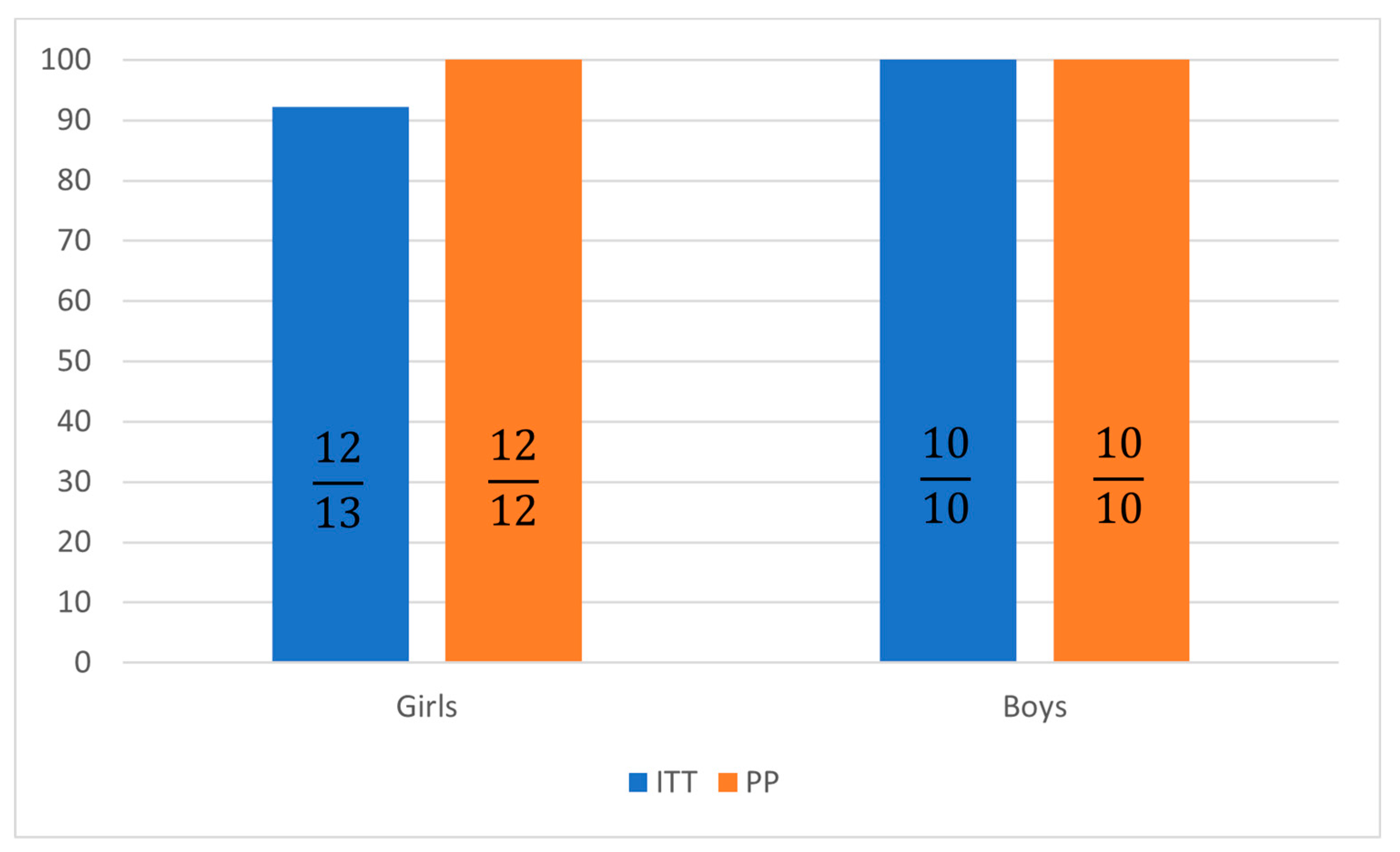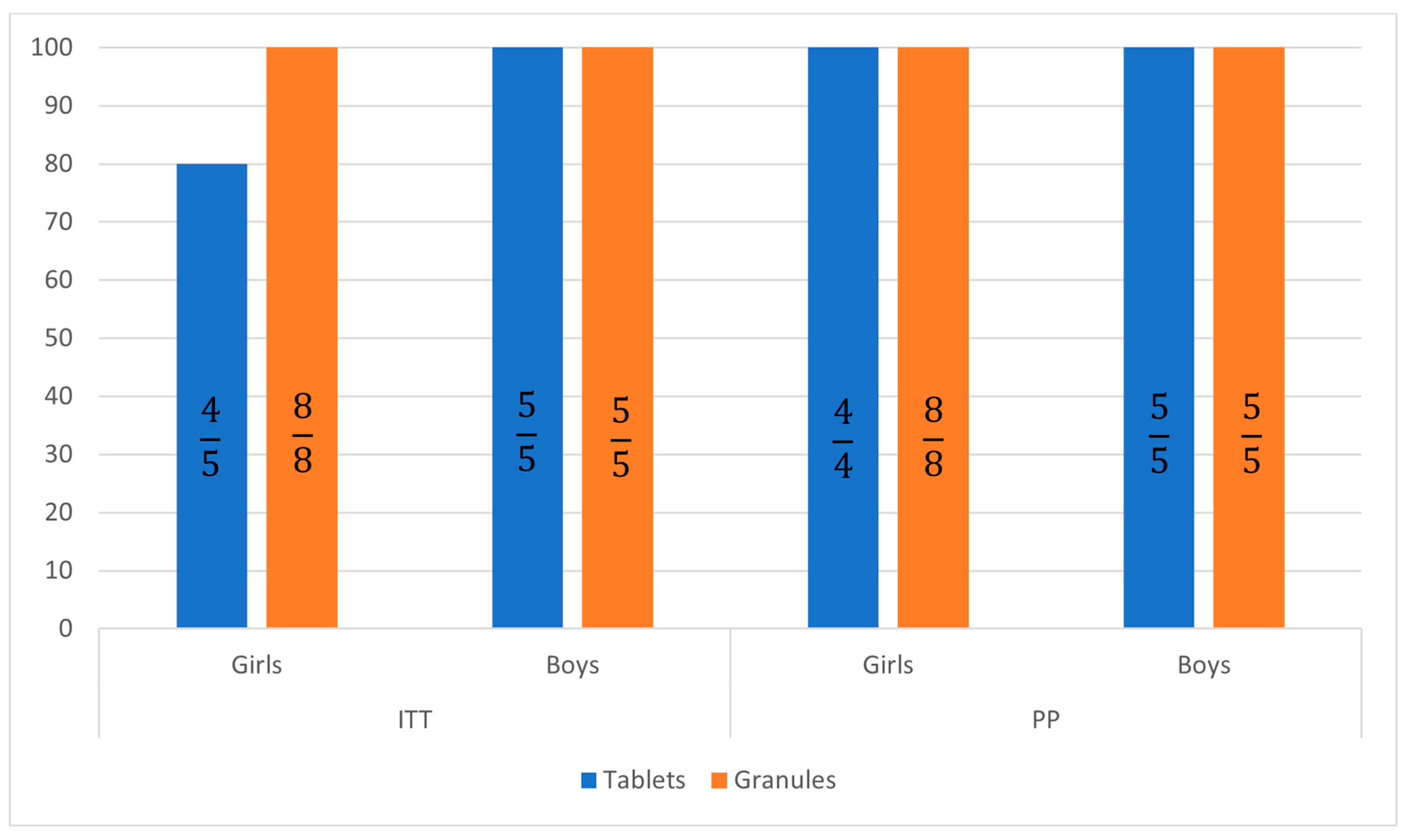Real-World Efficacy and Safety of an 8-Week Glecaprevir/Pibrentasvir Regimen in Children and Adolescents with Chronic Hepatitis C—Results of a Multicenter EpiTer-2 Study
Abstract
:1. Introduction
2. Materials and Methods
2.1. Study Population
2.2. Data Collection
2.3. Assessment of Liver Disease Severity
2.4. HCV Treatment Regimen
2.5. Assessment of Safety
2.6. Ethics
2.7. Statistical Analysis
3. Results
3.1. Patients’ Baseline Characteristics and Laboratory Parameters
3.2. Treatment Effectiveness and Safety
4. Discussion
5. Conclusions
Author Contributions
Funding
Institutional Review Board Statement
Informed Consent Statement
Data Availability Statement
Conflicts of Interest
References
- Indolfi, G.; Easterbrook, P.; Dusheiko, G.; El-Sayed, M.H.; Jonas, M.M.; Thorne, C.; Bulterys, M.; Siberry, G.; Walsh, N.; Chang, M.-H.; et al. Hepatitis C Virus Infection in Children and Adolescents. Lancet Gastroenterol. Hepatol. 2019, 4, 477–487. [Google Scholar] [CrossRef] [PubMed]
- Schmelzer, J.; Dugan, E.; Blach, S.; Coleman, S.; Cai, Z.; DePaola, M.; Estes, C.; Gamkrelidze, I.; Jerabek, K.; Ma, S.; et al. Global Prevalence of Hepatitis C Virus in Children in 2018: A Modelling Study. Lancet Gastroenterol. Hepatol. 2020, 5, 374–392. [Google Scholar] [CrossRef] [PubMed]
- Malik, F.; Bailey, H.; Chan, P.; Collins, I.J.; Mozalevskis, A.; Thorne, C.; Easterbrook, P. Where Are the Children in National Hepatitis C Policies? A Global Review of National Strategic Plans and Guidelines. JHEP Rep. 2021, 3, 100227. [Google Scholar] [CrossRef] [PubMed]
- Blach, S.; Terrault, N.A.; Tacke, F.; Gamkrelidze, I.; Craxi, A.; Tanaka, J.; Waked, I.; Dore, G.J.; Abbas, Z.; Abdallah, A.R.; et al. Global Change in Hepatitis C Virus Prevalence and Cascade of Care between 2015 and 2020: A Modelling Study. Lancet Gastroenterol. Hepatol. 2022, 7, 396–415. [Google Scholar] [CrossRef] [PubMed]
- Melikoki, V.; Kourlaba, G.; Kanavaki, I.; Fessatou, S.; Papaevangelou, V. Seroprevalence of Hepatitis C in Children without Identifiable Risk-Factors: A Systematic Review and Meta-Analysis. J. Pediatr. Gastroenterol. Nutr. 2021, 72, e140–e148. [Google Scholar] [CrossRef] [PubMed]
- Modin, L.; Arshad, A.; Wilkes, B.; Benselin, J.; Lloyd, C.; Irving, W.L.; Kelly, D.A. Epidemiology and Natural History of Hepatitis C Virus Infection among Children and Young People. J. Hepatol. 2019, 70, 371–378. [Google Scholar] [CrossRef] [PubMed]
- World Health Organization. Updated Recommendations on Treatment of Adolescents and Children with Chronic HCV Infection, and HCV Simplified Service Delivery and Diagnostics; World Health Organization: Genève, Switzerland, 2022. [Google Scholar]
- Greenaway, E.; Haines, A.; Ling, S.C.; Krahn, M. Treatment of Chronic Hepatitis C in Young Children Reduces Adverse Outcomes and Is Cost-Effective Compared with Deferring Treatment to Adulthood. J. Pediatr. 2021, 230, 38–45.e2. [Google Scholar] [CrossRef] [PubMed]
- Tomasiewicz, K.; Flisiak, R.; Jaroszewicz, J.; Małkowski, P.; Pawłowska, M.; Piekarska, A.; Simon, K.; Zarębska-Michaluk, D. Recommendations of the Polish Group of Experts for HCV for the Treatment of Hepatitis C in 2023. Clin. Exp. Hepatol. 2023, 9, 1–8. [Google Scholar] [CrossRef]
- Jonas, M.M.; Squires, R.H.; Rhee, S.M.; Lin, C.-W.; Bessho, K.; Feiterna-Sperling, C.; Hierro, L.; Kelly, D.; Ling, S.C.; Strokova, T.; et al. Pharmacokinetics, Safety, and Efficacy of Glecaprevir/Pibrentasvir in Adolescents with Chronic Hepatitis C Virus: Part 1 of the DORA Study. Hepatology 2020, 71, 456–462. [Google Scholar] [CrossRef]
- Jonas, M.M.; Rhee, S.; Kelly, D.A.; Del Valle-Segarra, A.; Feiterna-Sperling, C.; Gilmour, S.; Gonzalez-Peralta, R.P.; Hierro, L.; Leung, D.H.; Ling, S.C.; et al. Pharmacokinetics, Safety, and Efficacy of Glecaprevir/Pibrentasvir in Children with Chronic HCV: Part 2 of the DORA Study. Hepatology 2021, 74, 19–27. [Google Scholar] [CrossRef]
- Halota, W.; Flisiak, R.; Juszczyk, J.; Małkowski, P.; Pawłowska, M.; Simon, K.; Tomasiewicz, K. Recommendations of the Polish Group of Experts for HCV for the Treatment of Hepatitis C in 2020. Clin. Exp. Hepatol. 2020, 6, 163–169. [Google Scholar] [CrossRef] [PubMed]
- EMA Maviret. Available online: https://www.ema.europa.eu/en/medicines/human/EPAR/maviret (accessed on 26 August 2023).
- European Association for the Study of the Liver. Electronic Address: Easloffice@easloffice.Eu, Clinical Practice Guideline Panel, Chair:; et al. EASL Clinical Practice Guidelines on Non-Invasive Tests for Evaluation of Liver Disease Severity and Prognosis—2021 Update. J. Hepatol. 2021, 75, 659–6899. [Google Scholar] [CrossRef] [PubMed]
- Mizuochi, T.; Iwama, I.; Inui, A.; Ito, Y.; Takaki, Y.; Mushiake, S.; Tokuhara, D.; Ishige, T.; Ito, K.; Murakami, J.; et al. Real-World Efficacy and Safety of Glecaprevir/Pibrentasvir in Japanese Adolescents with Chronic Hepatitis C: A Prospective Multicenter Study. J. Gastroenterol. 2023, 58, 405–412. [Google Scholar] [CrossRef] [PubMed]
- Ohya, K.; Kawaoka, T.; Imamura, M.; Morio, K.; Nakahara, T.; Murakami, E.; Yamauchi, M.; Hiramatsu, A.; Tsuge, M.; Aikata, H.; et al. Three Children Treated with Direct-Acting Antivirals for Chronic Hepatitis C Virus Genotype 1b Infection. Intern. Med. 2020, 59, 941–944. [Google Scholar] [CrossRef] [PubMed]
- Sato, K.; Yamazaki, Y.; Kanayama, Y.; Uehara, D.; Tojima, H.; Suga, T.; Kakizaki, S.; Sohara, N.; Horiguchi, N.; Uraoka, T. Adolescents with Chronic Hepatitis C Might Be Good Candidates for Direct-Acting Antiviral Therapy. Clin. Case Rep. 2022, 10, e05690. [Google Scholar] [CrossRef] [PubMed]
- Fukuoka, T.; Bessho, K.; Hosono, S.; Abukawa, D.; Mizuochi, T.; Ito, K.; Murakami, J.; Tanaka, H.; Miyoshi, Y.; Takano, T.; et al. The Impact of Treatment on the Psychological Burden of Mothers of Children with Chronic Hepatitis C Virus Infection: A Multicenter, Qu.estionnaire Survey. Sci. Rep. 2022, 12, 22116. [Google Scholar] [CrossRef] [PubMed]


| Parameters | Values n = 23 |
|---|---|
| Age, mean (SD) (years), (min–max) | 9.61 (3.68), (3–17) |
| Gender, n (%) (female/male) | 13/10 (56.5/43.5) |
| BMI, mean (SD) | 18.64 (4.37) |
| Genotypes, n (%) | |
| 1 | 15 (65.2) |
| 1a | 6 (26.1) |
| 1b | 9 (39.1) |
| 2 | 0 (0) |
| 3 | 5 (21.7) |
| 4 | 3 (13) |
| Fibrosis/stiffness, n (%) | |
| F0 | 11 (47.8) |
| F1 | 1 (4.3) |
| F2 | 0 |
| F3 | 0 |
| F4 | 0 |
| Unknown | 11 (47.8) |
| HCC history, n (%) | 0 |
| Liver transplantation history, n (%) | 0 |
| HIV coinfection, n (%) | 0 |
| HBV coinfection, n (%) | 1 (4.3) |
| Any comorbidity, n (%) | 1 (4.3) |
| Renal diseases | 1 (4.3) |
| Concomitant medications, n (%) | 0 |
| Parameters | Tablets n = 10 | Granules n = 13 |
|---|---|---|
| Age, mean (SD) (years), (min–max) | 13.20 (1.72), (11–17) | 7 (2.03), (3–10) |
| Gender, n (%) (female/male) | 5/5 (50/50) | 8/5 (61.5/38.5) |
| BMI, mean (SD) | 22.51 (3.59) | 15.65 (1.86) |
| Genotypes, n (%) | ||
| 1 | 6 (60.0) | 9 (69.2) |
| 1a | 1 (10.0) | 5 (38.5) |
| 1b | 5 (50.0) | 4 (30.8) |
| 2 | 0 (0) | 0 (0) |
| 3 | 3 (30.0) | 2 (15.4) |
| 4 | 1 (10.0) | 2 (15.4) |
| Fibrosis/stiffness, n (%) | ||
| F0 | 5 (50) | 6 (46.2) |
| F1 | 1 (10) | 0 (0) |
| F2 | 0 (0) | 0 (0) |
| F3 | 0 (0) | 0 (0) |
| F4 | 0 (0) | 0 (0) |
| Unknown | 4 (40) | 7 (53.8) |
| HCC history, n (%) | 0 (0) | 0 (0) |
| Liver transplantation history, n (%) | 0 (0) | 0 (0) |
| HIV coinfection, n (%) | 0 (0) | 0 (0) |
| HBV coinfection, n (%) | 1 (10) | 0 (0) |
| Any comorbidity, n (%) | ||
| Kidney diseases | 1 (10) | 0 |
| Concomitant medications, n (%) | 0 | 0 |
| Parameters | Values n = 23 |
|---|---|
| HCV RNA, median (IQR) [IU/L] | 645,000 (229,324–1,865,000) |
| ALT, median (IQR) [IU/L] | 46 (37.5–58.5) |
| Albumin, median (IQR) [g/dL] | 4.63 (4.46–4.87) |
| Biblirubin, median (IQR) [mg/dL] | 0.46 (0.37–0.56) |
| Platelets ×1000/µL, median (IQR) | 323 (260–378.5) |
| Creatinine, median (IQR) [mg/dL] | 0.46 (0.4–0.57) |
| Hemoglobin, median (IQR) [g/dL] | 13.6 (12.75–13.9) |
| INR, median (IQR) | 1.08 (1.05–1.12) |
| Parameters | Tablets n = 10 | Granules n = 13 |
|---|---|---|
| HCV RNA, median (IQR) [IU/mL] | 521,500 (353,000–1,437,500) | 735,000 (107,000–2,030,000) |
| ALT, median (IQR) [IU/L] | 47.5 (42.75–64.25) | 43 (33–49) |
| Albumin, median (IQR) [g/dL] | 4.70 (4.63–5.1) | 4.57 (4.30–4.72) |
| Biblirubin, median (IQR) [mg/dL] | 0.51 (0.45–0.68) | 0.43 (0.34–0.50) |
| Platelets ×1000/µL, median (IQR) | 242 (197–313) | 367 (305–416) |
| Creatinine, median (IQR) [mg/dL] | 0.62 (0.54–0.77) | 0.42 (0.39–0.45) |
| Hemoglobin, median (IQR) [g/dL] | 13.80 (13.60–13.90) | 13 (12.40–13.8) |
| INR, median (IQR) | 1.10 (1.06–1.11) | 1.06 (1.04–1.12) |
| Parameter | Values |
|---|---|
| Number of patients, n | 23 |
| Treatment course, n (%) | |
| According to schedule | 23 (100) |
| Therapy modification | 0 |
| Therapy discontinuation | 0 |
| Patients with at least one AE, n (%) | |
| Nausea | 1 (4.3) |
| Fatigue | 1 (4.3) |
| Parameter | Tablets | Granules |
|---|---|---|
| Number of patients, n | 10 | 13 |
| Treatment course, n (%) | ||
| According to schedule | 10 (100) | 13 (100) |
| Therapy modification | 0 (0) | 0 (0) |
| Therapy discontinuation | 0 (0) | 0 (0) |
| Patients with at least one AE, n (%) | ||
| Nausea | 1 (10.0) | 0 (0) |
| Fatigue | 1 (10.0) | 0 (0) |
Disclaimer/Publisher’s Note: The statements, opinions and data contained in all publications are solely those of the individual author(s) and contributor(s) and not of MDPI and/or the editor(s). MDPI and/or the editor(s) disclaim responsibility for any injury to people or property resulting from any ideas, methods, instructions or products referred to in the content. |
© 2023 by the authors. Licensee MDPI, Basel, Switzerland. This article is an open access article distributed under the terms and conditions of the Creative Commons Attribution (CC BY) license (https://creativecommons.org/licenses/by/4.0/).
Share and Cite
Pawlowska, M.; Dobrowolska, K.; Moppert, J.; Pokorska-Śpiewak, M.; Purzynska, M.; Marczynska, M.; Zarebska-Michaluk, D.; Flisiak, R. Real-World Efficacy and Safety of an 8-Week Glecaprevir/Pibrentasvir Regimen in Children and Adolescents with Chronic Hepatitis C—Results of a Multicenter EpiTer-2 Study. J. Clin. Med. 2023, 12, 6949. https://doi.org/10.3390/jcm12216949
Pawlowska M, Dobrowolska K, Moppert J, Pokorska-Śpiewak M, Purzynska M, Marczynska M, Zarebska-Michaluk D, Flisiak R. Real-World Efficacy and Safety of an 8-Week Glecaprevir/Pibrentasvir Regimen in Children and Adolescents with Chronic Hepatitis C—Results of a Multicenter EpiTer-2 Study. Journal of Clinical Medicine. 2023; 12(21):6949. https://doi.org/10.3390/jcm12216949
Chicago/Turabian StylePawlowska, Malgorzata, Krystyna Dobrowolska, Justyna Moppert, Maria Pokorska-Śpiewak, Mariola Purzynska, Magdalena Marczynska, Dorota Zarebska-Michaluk, and Robert Flisiak. 2023. "Real-World Efficacy and Safety of an 8-Week Glecaprevir/Pibrentasvir Regimen in Children and Adolescents with Chronic Hepatitis C—Results of a Multicenter EpiTer-2 Study" Journal of Clinical Medicine 12, no. 21: 6949. https://doi.org/10.3390/jcm12216949
APA StylePawlowska, M., Dobrowolska, K., Moppert, J., Pokorska-Śpiewak, M., Purzynska, M., Marczynska, M., Zarebska-Michaluk, D., & Flisiak, R. (2023). Real-World Efficacy and Safety of an 8-Week Glecaprevir/Pibrentasvir Regimen in Children and Adolescents with Chronic Hepatitis C—Results of a Multicenter EpiTer-2 Study. Journal of Clinical Medicine, 12(21), 6949. https://doi.org/10.3390/jcm12216949











